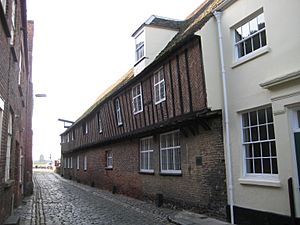Treaty of Utrecht (1474) facts for kids
The Treaty of Utrecht was a peace agreement signed in 1474. It ended a war between England and the Hanseatic League, a powerful group of trading cities in northern Europe. This war, known as the Anglo-Hanseatic War, had been going on since 1470.
Contents
What Was the Anglo-Hanseatic War?
This war was mainly fought at sea. Both sides used a strategy called commerce raiding. This meant they attacked each other's trading ships in the North Sea and the English Channel. One famous warship from this time was the Peter von Danzig.
Why Did the War Start?
The main reason for the war was trade. Cities like Danzig and Lübeck, which were part of the Hanseatic League, felt that England was putting too much pressure on their trade. They traded a lot along the southern coast of the Baltic Sea.
At the same time, England was having financial problems. The country was almost bankrupt after many years of war and poor management. This made it hard for England to keep up the fight.
What Did the Treaty of Utrecht Do?
The treaty brought peace between England and the Hanseatic League. It also gave back special trading rights to the Hanseatic cities in the Port of London.
Hanseatic Privileges in London
These special rights meant that Hanseatic traders did not have to pay certain taxes, like the Tunnage and Poundage levy. These tax breaks had been promised to them before, in a treaty signed in 1437.
The treaty also gave the Hanseatic League full ownership of their main trading base in London, called the Steelyard. This property stayed theirs until the mid-1800s. Many Londoners were not happy about this, as they felt it was unfair to their own merchants.
Access to Ports and Trade
The Hanseatic League was also guaranteed access to important English ports like Hull, Lynn, and Boston. They even got a claim to receive £10,000 each year from customs duties.
For England, the treaty was a partial defeat. They gave up some tax money and trading rights. In return, they gained peace with Germany and could trade more easily with the Netherlands. However, English trade did not fully recover in Germany or the Baltic Sea until much later.
The Hanseatic Warehouse in King's Lynn
An important result of the treaty was the construction of the Hanseatic Warehouse in King's Lynn. It was built in 1475. This allowed the Hanseatic League to set up a trading center in Lynn for the first time.
The warehouse was used for trade until 1751. Today, it is the only building left in England that belonged to the Hanseatic League.


